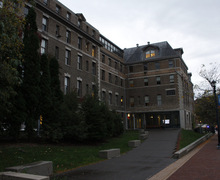Habitat for Humanity sees rise in registration
Habitat for Humanity at Syracuse University saw its largest and fastest registration for its Spring Break service trips Friday, filling all six trips to capacity for the first time.
Habitat for Humanity, which includes students from SU and the State University of New York College of Environmental Science and Forestry, has never seen such an immediate interest in the trips, said Andrea Rosko, the Spring Break coordinator for SU/ESF Habitat for Humanity.
‘In the past, it usually took two months,’ Rosko said. ‘Usually, students are slow to fill out the forms. But immediately when we opened registration, there were already 20 students waiting outside the cubicle.’
Sign-ups began Friday at 9 a.m., but students were in line as early as 7:45 a.m., said Justin Cole, executive director of SU/ESF Habitat for Humanity.
A reason for the rapid sign-up could be the change in the registration process, Rosko said. This is the first year that students have been able to sign up for the trips in person at the Habitat office in 126 Schine Student Center.
Another reason why the Spring Break trips were so popular this year may be because tragedies like the earthquake in Haiti raise awareness about the need for action, Cole said.
‘Out of every tragedy comes a sense of obligation that we recognize everyone isn’t as lucky as we are here at a private university,’ Cole said. ‘While people realize it would be nice to spend a week in Tijuana or Lake Tahoe, they also want to do whatever they can and give back when people need it.’
This year Habitat has six different trips planned for Spring Break: Birmingham, Ala.; Mobile, Ala.; Almost Heaven, W.Va.; Jacksonville, Fla.; St. Tammany West, La.; and Chatham County, N.C. Most of these trips head out around 4:30 a.m. the first Saturday of Spring Break.
Rosko had planned for 108 volunteer spots across the six different building sites last semester. But after Friday’s registration turnout, Rosko expanded that number to 130 to include the 22 wait-listed students, she said.
Each trip consists of about 20 students from ESF and SU. Volunteers do not have to be a member of the campus Habitat club to sign up for the Spring Break trips. The Spring Break trips are usually the first time students volunteer with Habitat, and many become members of the club thereafter, Rosko said.
‘That same afternoon I placed calls to the affiliates to see how much wiggle room they had,’ Rosko said. ‘Most of them were more than welcome to accept more volunteers.’
Rosko said she will most likely be going on the trip to Almost Heaven, W. Va.
‘The place we’re going is relatively rural, and the surrounding area is gorgeous,’ Rosko said. ‘But they also have some of the highest poverty rates and housing issues.’
Wherever Habitat goes, there are usually major issues regarding poverty or disaster relief, Rosko said.
When they arrive at the building site, the local affiliate of Habitat distributes the students among the building projects. At any given site, there are three to 12 houses under construction.
Typically, students work on the building site four to five days during Spring Break, eight hours each day. Student volunteers work on all aspects of the building process, including roofing, tiling and carpeting floors, depending on how far along the building is.
Currently, SU Habitat travels by carpool to all of its service trips in order to save money. The long car ride is also important for building friendships between students who usually begin the trip as strangers, Rosko said.
‘What better way to get to know people than spending upwards of 15 hours in a car with them?’ Rosko said.
Habitat volunteers do not get formal training in construction, said Cole, executive director of SU/ESF Habitat for Humanity.
‘When you pitch the idea to people that don’t know about us, saying you send 20 unskilled laborers to the most impoverished areas, people think you’re crazy,’ Cole said. ‘But you understand it when you see it happen.’
In addition to untrained Habitat volunteers, there are usually trained AmeriCorps volunteers and retired construction workers at each site that help volunteers learn the ins and outs of building houses, Cole said.
‘I’ve seen students go down and not be able to put a nail into a single board,’ Cole said. ‘By the end, they’re working just as well as any construction worker. You really take a lot of pride in your work.’
Published on February 8, 2010 at 12:00 pm





